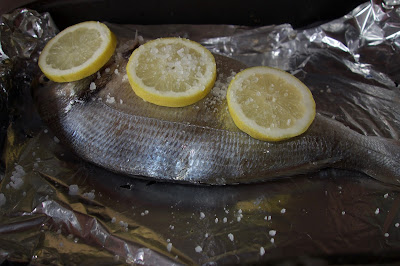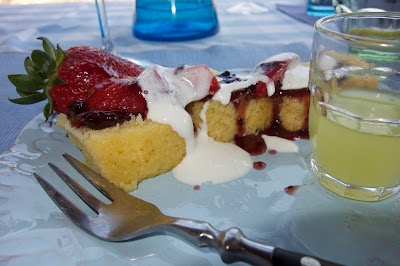 |
| Our perfect hostess, Daniella |
It’s mid morning. We lounge
idly in canvas backed lawn chairs, on the sun-blessed terrace of Daniella’s
eclectic home and wait for her to return with a chilled bottle of
Prosecco. Below us, in the near distance
sits the placidly picturesque blue Mediterranean and old town Monterosso, with
its colorful buildings clustered on the hillside below us. It’s our fourth day in the World Heritage
Site of Cinque Terre (Chink-co-terra).
We’ve wandered the
cobblestones, admired the work of artisans, stared up at laundry hanging on the
balconies of ancient buildings, slain the fatted calf a dozen times over, and
soaked in the culture of the small fishing villages turned tourist Meccas. This morning we wandered the local market,
admiring fresh vegetables and fresh catch, while throngs of locals bartered and
filled their shopping bags. Have we had enough?
Seen it all? Not hardly, no way.
We’ve already met so many
people. Franco the short, graying taxi
driver who lost his cab, Elania, the beautiful girl who works an outdoor café
on the waterfront, another taxi driver named Franco, several watercolor
artists, and Swiss, German, and yes---Italian--- tourists.
We’re wonderfully accommodated
in one of Daniella’s hillside villas and now we’ve walked up a hundred stone
steps to get to her home for an afternoon’s Italian cooking lesson. Let’s be more specific and call it a Ligurian
cooking lesson, for this is the Italian Riviera, spread along a rugged coastline,
with its own tastes and styles of cooking.
Much of it features local olives, lemons, and seafood straight off any
of the many small fishing vessels that line the harbor and rest on the sand. Daniella even has a lemon tree on the terrace.
The promised Prosecco arrives
and we are ever grateful. We sip gently
and pop fat green olives in our mouths, between bites of deliciously crunchy
bread.
 |
| Wonderful, giant capers! |
Yes, I already feel as if I could
live here, so long as the money holds out and my liver doesn’t desert me. If wine is as good for you as they say it is,
my arterial plaque is in for the fight of its life. No, Prosecco is not from around here, but
Prosecco has a vast variety of local cousins that have already helped us down
quantities of fresh seafood. Now I’m wondering what new wonders of the Ligurian
kitchen Daniella can show us?
First off is the kitchen
itself. It’s built into a corner of her
terrace and is so quaintly lovely it should have come out of a romantic movie,
starring Audrey Hepburn and Cary Grant.
In addition to an array of cooking implements hanging serenely above the
tiles on the wall, there’s a four-burner gas stove, and a stone sink I plan to
steal. Except for three things: it’s too heavy, more wine may slow me down,
and Daniella’s husband may be too ferocious.
I don’t know for sure, but I can’t take the chance.
The expansive terrace is
itself an architectural dream, with tiled floor, green plants, colorful
flowers, that fruit bearing lemon tree, and glorious views in every
direction. Daniella turns out not only to
be an exceptional cook, but a talented decorator.
 |
| The basil must be thoroughly dry. Daniella shows us how. |
See, I meant to simply tell
you about a cooking lesson, but got carried away. Cinque Terre is like that. A bombardment of sun, style, friendly people,
and an entirely different way of life.
So, back to cooking. But, first I must mention the second wine
Daniella served, a local white, and it is delightfully fruity and dry. But, it’s not the best, says Daniella
modestly. Wait until you taste our best
local wine. If the wine we’re sipping is
not the best, my knees may weaken and I may try out my Italian tenor’s voice.
So, as I said, back to
cooking. We’re going to make pesto,
casserole chicken, lasagna, and baked fresh fish. Those are the common American names. I’ll give you the more charming and
descriptive Italian names later. You can
be sure, all the dishes will include fresh – from the garden and the sea –
ingredients.
First we hand make the basil pesto
in an old stone mortar. And with the
first stone-on-stone scraping of the pestle against the mortar, Daniella begins
to delight us with tales of food and family, heritage, and the wonders of an
Italian-American wife living with a locally born Italian husband, in the most
Italian place in the world. Along the
way, this requires her listeners to acquire a taste for several more bottles of
local wine. Her fascinating story,
enthralls us with all the elements of history, romance, and family struggles that
make up a great novel.
 |
| Ingredients for Lasagna |
 |
| The creamiest, more delicious Parmesan! An essential in all the dishes we prepared. |
But, once again I digress. With the pesto, the remainder of which is
made in a food processor, we have the first ingredient in what will become the
most delicious lasagna I’ve ever tasted.
The other ingredients include flat pasta, of course, plus a silky
béchamel sauce, and a generous handful of pine nuts.
 |
| Lunch is a hands-on culinary experience! |
 |
| Making the béchamel |
The oven is inside and in it goes, while we
start work on a wonderful chicken casserole, called Pollo Piero.
 |
| Other ingredients for Pollo Piero |
The main ingredient for Pollo
Piero is skinless, bone-in, chicken thighs, followed by a deluge of bell
peppers, onions, tomatoes, and seasonings.
Note: Italian cooks do not
normally use onions and garlic in the same dish, although for the accompanying
asparagus dish a full head of unpeeled garlic will have the bottom sliced off
and accompany the vegetable platter as it’s slipped in the oven.
Sea bass, right off the boat,
is baked Liturigan style, meaning rosemary, salt and lemon in the fish cavity,
with more of the same and olive oil over the top. Yes, it’s a whole fish, with the sides
slashed to permit the oil and lemon to penetrate the flesh.
For dessert, we have freshly
made lemon cake, with cream and berries, along with short glasses of Daniella’s
homemade Limonchello. To make
Limonchello, there are only four ingredients: lemons, vodka, water, and sugar. Lots of recipes online.
Daniella’s lunch only lasts
about 4-5 hours. I stop counting after
the second bottle of wine. Delicious
doesn’t really explain it. A lunch on
her terrace is an all-encompassing experience of incomparable tastes,
scintillating conversations, carefree humorous banter, all delivered under blue
skies, and in the glow of scenery that will forever live in memory. A complete adventure in Italian living. Now
if I can only figure out how to separate Daniella from her stone sink…
 |
| Perfection! |




























